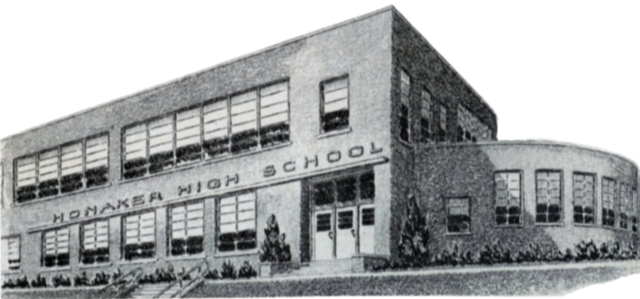

Honaker is located in the Northeastern section of Russell County with the Appalachian Range serving as a picturesque background of valleys and cloud-covered mountains. Lying at the foot of Big “A” Mountain, Honaker serves as a gateway to the Breaks Interstate Park, the Grand Canyon of the South.
Honaker’s history began in 1786, when Russell County was separated from Washington County by legislation introduced into the General Assembly by delegates Andred Kinneannon and General William Russell, the latter for whom the county was subsequently named.
At that time, Russell County was one of the largest counties in the state, extending from the Clinch Mountain Range to the Virginia-Tennessee state line with an area of approximately thirty-two thousand square miles. Russell County can be appropriately called a “mother of counties” since the following counties were created from Russell County: Tazewell, Lee, Scott, Wise, Buchanan, and Dickenson.
Prior to the formation of the county, Indians, as well as settlers, occupied the area and used it as a hunting ground. However, in 1768, because of the strained relationship with the Indians, many forts had to be erected to protect the settlers and their families. Indian massacres were common as late as the 1790’s.
The present day Honaker evolved from two sections, one called “Old Honaker” on Lewis Creek near what is now known as Cox Town, and the other near the old railroad depot which was torn down in 1983 because passenger and freight service was discontinued. In the tradition of the county’s historical ancestry, the name “Honaker” can be traced to an old name from Europe which means “place at the foot of a mountain.”
On December 4, 1849, a United States Post Office was established in “Squire” Honaker’s store and the address was New Garden. In 1884, it was changed to Honaker and the story goes that “Squire” Honaker persuaded the Postal Department to change it and name it in his honor. Although Honaker was founded in 1840, the town never really boomed until the Norfolk and Western Railroad came through the town in 1889. With the arrival of the railroad, stores and businesses were erected near the railroad station. Soon after the railroad was built, the Honaker Lumber Company was established and began shipping lumber to furniture plants in the east. The company bought 4,100 acres of timber and became one of the largest sawmills in the eastern United States.
The history of Honaker indicates that the people were concerned with the education of their children. After the Civil War, Captain E. D. Miller came into the “Old Honaker” area to teach in a new building, “The Academy,” built by Thomas Davis and John N. Kendrick as the first free school in the community. In 1895, Old Dominion College was established by Professors Alson Hutton and John D. Kendrick. The school was located in the area near the former Piggly Wiggly and Western Auto Stores. The college was sold to the county in 1904 and was used as a school until the first public high school with H. C. Williams as principal opened in the Fairmont section of town. Grades one through seven had free tuition; a fee of two dollars per month was charged to attend high school. Three students were in the first graduation class of 1912.
Traditionally, social life in the community centered around the schools. At one time, high school graduation was a five-day affair, serving as a social get-together for family and friends. For many years, the New Garden Fair was held in the gymnasium in the area that is today the high school parking area. The fair was held once a year until World War II. At that time, it was discontinued and later moved to Lebanon where it became known as the Russell County Fair and Horse Show.
As enrollment in the free school increased, a new building was erected in 1927 on the present site of the parking area. This building contained grades one through eleven. Honaker High School was an eleven-year school system until the 1957-58 school year when the present twelve-year grade division was adopted.
The present high school was built in 1952, and the old building was used as an elementary school. Both schools were considered a combined school under the leadership of one principal. A new elementary school was built on a different site in 1964, at which time Honaker High School and Honaker Elementary School became two separate centers of learning. In 1971, the present A.P. Baldwin Gymnasium was completed, and in 1987, ten new classrooms were added.
Following Williams as the principal of the first high school were E. E. Givens, Roy Horn, A. A. Countiss, Roger Butt, Lynn Moore, Roger Wright, A. P. Baldwin, Bill Ed Sample, Joseph White, H. G. Musick Jr., David C. Musick, Harry Steffey, Jackie Farrington, and the present principal, Tony Bush.

